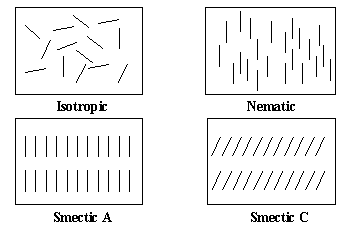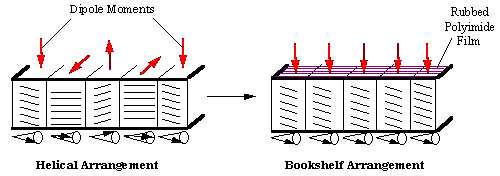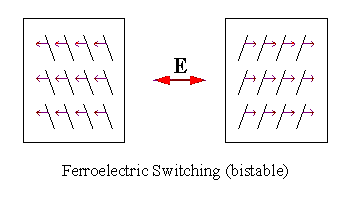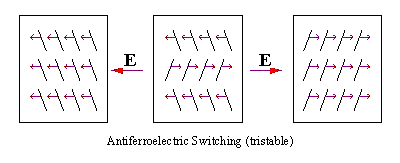|
|
||
|
Liquid Crystals Relevant Liquid Crystal Background
Everyday experience has led to universal
familiarity with the three states of matter: solids, liquids, and gases.
However, there are many organic materials that demonstrate more than a
single transition in passing from a liquid to a solid, thereby neces sitating
the description of one or more intermediate phases. The mechanical properties
and intermolecular packing arrangements of these phases are in between
those of a liquid and those of a crystal. They have partial ordering of
molecules similar to so lids, while maintaining the ability to flow akin
to liquids. Therefore, these materials are classified as liquid crystals
and exhibit one or more liquid crystalline phases, or more properly, mesophases.
The study of liquid crystals began in 1888 when Friedrich Reinitzer[1], an Austrian botanist, observed that
a material known as cholesteryl benzoate had two distinct melting points.
Since then, it has been shown that numerous compounds exhibit this type
of behavior. However, it was not until the last twenty years that this
area of materials research experienced explosive growth, primarily due
to the successful applications of liquid crystals in the area of electro-optical
displays.
There are two main classifications of liquid crystals, thermotropic and lyotropic, which are distinguished
by the mechanisms that drive their self-organization. Lyotropic liquid
crystal transitions occur with the influence of solvents and these mesogens
are of great interest biologically and appear to play an important role
in living systems. However, thermotropic liquid crystals are the focus
of this research and are characterized by mesophase transitions which are
most naturally effected by changing t emperature. A particular class of
thermotropic liquid crystals are made up of molecules with a rod-like structure.
These molecules typically possess rigidness of the long axis with strong
dipoles and/or easily polarizable substituents. The distinguishi ng characteristic
of these rod-like molecules is the tendency of the molecules to point along
a common axis called the director. A further classification is drawn from
the relative extent of lattice order preserved in the mesophase. For example,
in the isotropic state, there is no order of the director relative to other
molecules. The nematic phase demonstrates one-dimensional orientational
order, i.e., the molecules tend to align parallel to each other;
however, no positional order is present. A further degree of order is present
in the smectics. Not only do the molecules align with parallel directors,
but they also arrange in regularly spaced layers. It should be noted that
these phases are temperature dependent and a single liquid crystall ine
material can exhibit multiple mesophases. In the smectic A phase, the director
is perpendicular to the layer while the molecules in the smectic C phase
are uniformly tilted with respect to the layer normal.
Molecules which exhibit a Smectic C phase contain a polar substituent resulting in a dipole moment orthogonal
to the long axis of the molecule. In order to minimize intermolecular repulsions
combined with sterical considerations, the molecular axis tilt with respect
to the layer normal. Therefore, this phase possesses the following monoclinic
symmetry elements: a two-fold axis of rotation perpendicular to the long
molecular axes, a mirror plane parallel to the layers, and a center of
inversion. Howeve r, if a chiral center is introduced in the molecule,
then the mirror plane and the center of inversion are eliminated, leaving
only the polar C2 axis of rotation[2].
A molecule of this type was theoretically predicted by R.B. Meyer et. al.[3] to be ferroelectric. For a material
to be ferroelectric, the polar axis must be along a unique rotation axis
to which no perpendicular plane of reflection symmetry belong s[4]. A chiral
Smectic C (SmC*) is ferroelectric due to the inequivalence of the dipoles
along the C2 axis, even though the molecules are undergoing rapid reorientational
motion about their long axis[5]. This time dependent alignment of dipoles
along th e C2 axis causes a spontaneous polarization to arise parallel
to the smectic layer planes, resulting in a spontaneous polarization for
each individual layer. To ensure a zero bulk polarization, the spontaneous polarization
from layer to layer is s hifted slightly resulting in a helielectric phase[6].
Unwinding of this helix results in the layer polarizations all aligned
in the same direction and the entire bulk phase becomes ferroelectric.
Clark and Lagerwall[7] were the first
to take advantage of the ferroelectric nature of the SmC* phase to produce
an electro-optical device, known as the surface stabilized ferroelectric
liquid crystal display (SSFLCD). This device requires unwinding of t he
helical structure to ensure common alignment of the electric dipoles. This
is accomplished using glass cells spaced closer than the ferroelectric
helix pitch (the length required for one complete revolution of the helix).
The cell surfaces are coate d with a polyimide and unidirectionally rubbed,
causing the molecular layers near the surface to align with the direction
of rubbing. This results in smectic layers arranged perpendicular to the
glass plates and is known as the "bookshelf" arrangement.
There is a net polarization resulting from the aligning of the dipoles which is also perpendicular to the glass
plates. This polarization can couple to an externally applied field to
rotate the molecules either "up" or "down" resulting in either of two energetically degenerate states, or bistability.
Since these molecules are optically anisotropic in nature, the amount of polarized light transmitted through
such a material is strongly dependent on the molecular orientation. Therefore,
ferroelectric liquid crystals can act as optical shutters by the a pplication
of an alternating field when viewed between crossed polarizers. Unfortunately,
the interaction of the molecules with the rubbed polyimide surface is too
weak to ensure a durable cell. Surface perturbations can cause the loss
of the bookshelf arrangement, whereby the molecules immediately revert
to their helical conformation. Moreover, this molecular reordering is irreversible
and causes loss of function of the display.
In 1988, Chandani et. al.[8] reported the existence of another tilted smectic phase named the antiferroelectric
phase and designated it as SmCA* In an antiferroelectric ordering, molecules
reverse their tilt directions on passing from layer to lay er, where the
polarization vectors in subsequent layers point in opposite directions,
thereby canceling each other[9]. As a consequence, the spontaneous polarization
falls to zero and the driving force for a helical arrangement is removed.
One can think of the antiferroelectric ordering in terms of a ferroelectric
helix where the pitch length has been reduced to two adjacent smectic layers.
This phase shows tristable switching as shown in Figure 4 below.
Antiferroelectric materials have also been used for electro-optical devices. They have the advantage of no net
spontaneous polarization in the absence of an electric field, meaning they
orient strongly with the surface since there is no helical structure to
unwind. A positive or negative field of sufficient strength causes the
rotation of molecular dipoles in alternating layers such that all the directors
now align. Thus, a ferroelectric bookshelf geometry results, which will
again have a natural tende ncy to form a helix upon loss of the surface
stabilization. However, unlike the SSFLCD, this surface stablilization
can be regained by simply removing the field, resulting in the return of
the antiferroelectric phase which aligns well with the surface.
Liquid crystal polymers (LCP) represent another active area of research for use in advanced display devices. LCP
incorporate a unique combination of characteristics peculiar to liquid
crystals, i.e., polarizability, self assembly and fast response
times to external stimuli, and those typical to macromolecules, such as
durability, ease of processability and dimensional stability[10]. Also,
doping of LCP with a low molar mass ferroelectric liquid crystal of a similar
design allows for more competit ive switching speeds in conjunction with
the added durability gained from the stabilizing matrix of the LCP.
Another attempt to gain a partial stability advantage over singular molecular systems is to link together two mesogenic
units to form dimeric or twin liquid crystals. These 'Siamese-twin mesogens'
[11] consist of two identical mesogenic units which have been linked in
one of a variety of ways. These include; fused twins, such as those
studied by Kelker et. al. [12] and Malthete et.al. [13] where the mesogenic
units are linked rigidly by a ring system; the well studied head to
head twins[14 -16] which consist of the mesogenic units linked together
at their ends; or ligated twins where the molecules are connected
by a short spacer in a central position as first presented by Griffin et.
al. [17] and continued by Weissflog [18,19].
Project Aim: Flat panel display technology constitutes
the fastest growing segment of the semiconductor industry. These displays
take advantage of the fact that many of the physical properties of liquid
crystalline materials, such as birefringence, viscosity, and the rmal conductivity
are sensitive to relatively weak external stimuli, including electric fields,
magnetic fields, heat energy, and acoustical energy. Presently, the majority
of display related research is focused on the application of electro-optic
effect s due to the ease and efficiency of molecular reorientation with
an applied voltage as compared with other means of stimulation. One such
area of study is the surface stabilized ferroelectric liquid crystal (SSFLC)
display, which has many advantages over conventional cathode ray tubes
as well as other types of liquid crystal displays. The inherent limitation
encountered in SSFLC displays is that the interaction between liquid crystal
molecules and the device surfaces is too delicate to provide true surf
ace stabilization, which inevitably leads to device failure. It is the
goal of this research to overcome this shortcoming by designing liquid
crystal molecules which will have strong surface stabilization, yet maintain
the desirable switching characteris tics found in traditional ferroelectric
liquid crystals. In order to accomplish this, these molecules are designed
to have the advantages of dimeric, oligomeric, or polymeric stability while
incorporating the tristable states found in antiferroelectric m esogens.
References
1. F. Reinitzer, Monatsh Chem., 1888, 9, 421.
2. J.W. Goodby, Ferroelectrics, 1983, 49, 275.
3. R.B. Meyer, L. Liebert, L. Strzelecki, P. Keller, Le Journal De Physique Letters, 1975, 36, L69.
4. S.T. Lagerwall and I. Dahl, Mol. Cryst. Liq. Cryst., 1984, 114, 151.
5. J.W. Goodby, J. Mater. Chem., 1991, 1, 307.
6. H.R. Brand, P.E. Cladis, P.L. Finn, Phys. Rev. A, 1985, 31, 361.
7. N.A. Clark and S.T. Lagerwall, Appl. Phys. Lett., 1980, 36, 899.
8. A.D.L. Chandani and H. Takezoe, Jpn. J. Appl. Phys., 1988, 27, 729.
9. I. Nishiyama, Adv. Mater., 1994, 6, 966.
10. E. Chiellini, G. Galli, F. Cioni, E. Dossi, Makromol. Chem. , Macromol. Symp., 1993, 69, 51.
11. J. Malthete, J. Billard, J. Jacues, C. R. Acad. Sc. Paris, 1975, 281, 333.
12. H. Kelker and B. Scheurle, Molec. Crystals, 1969, 7, 381.
13. J. Malthete, C. R. Acad. Sc. Paris, 1983, 296, 435.
14. C. Aguilera, S. Ahmad, J. Bartulin, H. Muller, Mol. Cryst. Liq. Cryst., 1988, 162B, 277.
15. A. Ferrarini, G.R. Luckhurst, P.L. Nordio, S.J. Roskilly, Chem. Phys. Letters, 1993, 214, 409.
16. A.C. Griffin, S.R. Vaidya, R.S.L. Hung, S. Gorman, Mol. Cryst. Liq. Cryst. Letters, 1985, 1, 131.
17. A.C. Griffin, S.F. Thames, M.S. Bonner, Mol. Cryst. Liq. Cryst. Letters, 1977, 34, 135.
18. H. Dehne, A. Roger, D. Demus, S. Diele, H. Kresse, G. Pelzl, W. Wedler, W. Weissflog, Liquid Crystals, 1989, 6, 47.
19. W. Weissflog, D. Demus, S. Diele, P. Nitschke, W. Wedler, Liquid Crystals, 1989, 5, 111.
| |
|
|
||





